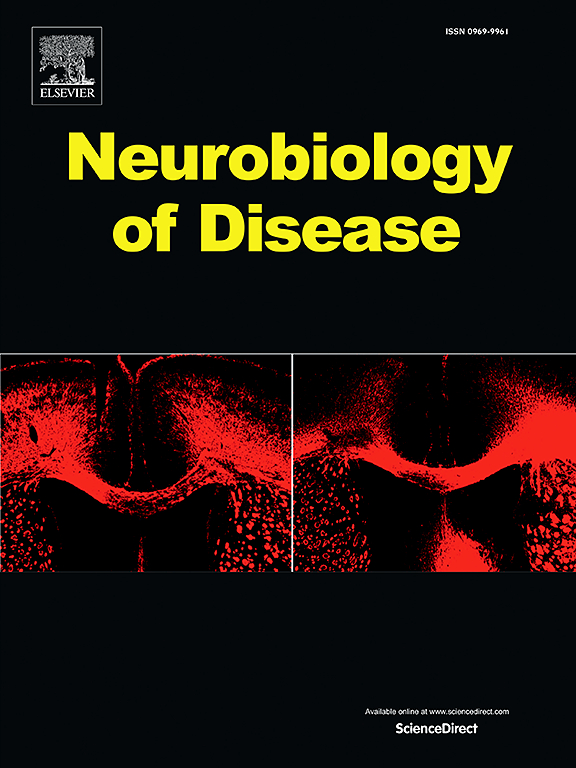在小鼠ALS/FTLD模型中,具有不同聚集特性的TDP-43突变体在疾病进展中表现出不同的毒性、轴突转运和分泌
IF 5.1
2区 医学
Q1 NEUROSCIENCES
引用次数: 0
摘要
TDP-43在肌萎缩性侧索硬化症(ALS)和额颞叶变性(FTLD)的神经元中积累并形成包涵体,并被认为是导致神经退行性过程的原因。在ALS/FTLD患者中,累积的TDP-43包涵体的形态、细胞分布和面积分布在病理上存在差异;然而,不同类型的TDP-43是否以及如何影响疾病进展的过程和严重程度尚不完全清楚。在此,我们比较了具有不同聚集特性的TDP-43突变在培养的小鼠神经元和大脑皮层中引起的病理事件。我们分别选择TDP-43C173/175S和TDP-43G298S作为聚集易感性和非聚集易感性突变体。胞质表达的TDP-43C173/175S诱导的不溶性包裹体比TDP-43G298S更强。相比之下,TDP-43G298S诱导细胞死亡的程度较TDP-43C173/175S更严重。进一步发现TDP-43G298S在轴突内有效转运并导致轴突变性,而TDP-43C173/175S的这种作用不明显。相反,TDP-43C173/175S经常被困在轴突初始段。最后,TDP-43G298S在体外外泌体中分泌,并比TDP-43C173/175S更有效地转移到少突胶质细胞系细胞中诱导细胞死亡。这种转移进一步引起了小胶质细胞的细胞因子反应。这些数据表明,不同的TDP-43聚集特性导致不同的病理事件。这些发现可以解释在ALS和FTLD患者中观察到的神经退行性进展和分布的差异。本文章由计算机程序翻译,如有差异,请以英文原文为准。

TDP-43 mutants with different aggregation properties exhibit distinct toxicity, axonal transport, and secretion for disease progression in a mouse ALS/FTLD model
TDP-43 accumulates and forms inclusions in neurons in amyotrophic lateral sclerosis (ALS) and frontotemporal lobar degeneration (FTLD) and is assumed to cause neurodegenerative processes. The morphologies and cellular and areal distributions of accumulated TDP-43 inclusions are pathologically diverse among ALS/FTLD patients; however, whether and how different types of TDP-43 affect the process and severity of disease progression are not fully understood. Here, we compared the pathological events evoked by TDP-43 mutations, which have different aggregation properties, in cultured neurons and the cerebral cortex in mice. We selected TDP-43C173/175S and TDP-43G298S as aggregation-prone and nonprone mutants, respectively. Cytoplasmically expressed TDP-43C173/175S induced insoluble inclusions more robustly than TDP-43G298S did. In contrast, TDP-43G298S induced cell death more severely than TDP-43C173/175S. TDP-43G298S was further found to be efficiently transported in axons and led to axon degeneration, while this effect was not obvious in TDP-43C173/175S. Instead, TDP-43C173/175S was frequently trapped in the axon initial segments. Finally, TDP-43G298S was secreted in exosomes and transferred to oligodendrocyte-lineage cells in vitro more efficiently than TDP-43C173/175S to induce cell death. The transfer further evoked cytokine responses in microglial cells. These data revealed that different aggregation properties of TDP-43 cause distinct pathological events. These findings may explain the differences in the neurodegenerative progression and distribution observed among patients with ALS and FTLD.
求助全文
通过发布文献求助,成功后即可免费获取论文全文。
去求助
来源期刊

Neurobiology of Disease
医学-神经科学
CiteScore
11.20
自引率
3.30%
发文量
270
审稿时长
76 days
期刊介绍:
Neurobiology of Disease is a major international journal at the interface between basic and clinical neuroscience. The journal provides a forum for the publication of top quality research papers on: molecular and cellular definitions of disease mechanisms, the neural systems and underpinning behavioral disorders, the genetics of inherited neurological and psychiatric diseases, nervous system aging, and findings relevant to the development of new therapies.
 求助内容:
求助内容: 应助结果提醒方式:
应助结果提醒方式:


